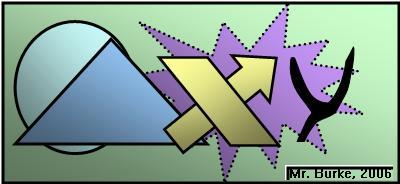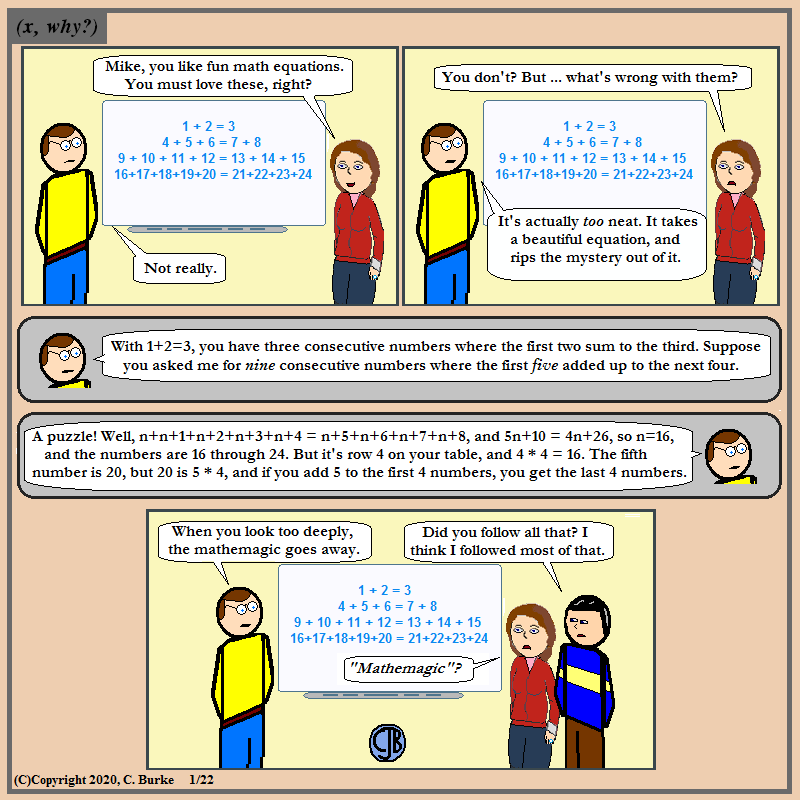Main Page
|
by Christopher J. Burke
|
 |
1556: The Mathemagic Goes Away

|
for a random comic 
|
It's kind of a cumulative effect. With any magic trick, if you look into it, you gain more understanding. However, if you do this, you lose some of the magic. One of the simplest, most beautiful equations in math is 1 + 2 = 3. The sum of two consecutive whole numbers add up to the third. You can't have three consecutive numbers add up to a fourth, but you can have it add up to a fourth and a fifth. If I didn't know what those numbers were, I could solve it by writing an equation:
And when I solve 3n + 3 = 2n + 7, I'd get n = 4, so 4 + 5 + 6 = 7 + 8. However, as the table gets filled in, it actually gets less exciting, even though there are exciting things happening in it. 1 + 2 = 3 4 + 5 + 6 = 7 + 8 9 + 10 + 11 + 12 = 13 + 14 + 15 16 + 17 + 18 + 19 + 20 = 21 + 22 + 23 + 24 25 + 26 + 27 + 28 + 29 + 30 = 31 + 32 + 33 + 34 + 35 ... = ... First, the numbers are consecutive. No number is skipped. Second, if we call the first row, Row 1, then Row 2, etc., we see that for Row N, there are N + 1 numbers on the left side and N numbers on the right side of the equation. Third, the first number in Row N is N2. But this isn't surprising because the first number is 1, and then we add 3 more numbers, and then add 5 more, and then add 7 more. From row to row, we are counting up by consecutive odd numbers, which means we are moving from one perfect square to the next. In every Row N, the last of the N + 1 numbers on the left side will be N2 + N. This makes the N numbers on the right side N2 + N + 1 through N2 + N + N. That last term on the left can be written as N(N + 1), and there are N terms before it on that side of the equation. This means that you can add (N + 1) to each of those N terms. If you do that, you get N2 + (N + 1), N2 + 1 + (N + 1) through N2 + (N - 1) + (N + 1), which are the exact terms on the right side. Thus, it isn't really a mystery at all why the two sides are equal. So, yes, I looked at it too closely, and the "mathemagic" went away. Final note: the title is a take on Larry Niven's "The Magic Goes Away". (You can also go there to leave comments!)    
|
for a random comic 
|

| DEC | Jan 2020 | FEB | |||||
| 29 | 30 | 31 | 1 | 2 | 3 | 4 | |
| 5 | 6 | 7 | 8 | 9 | 10 | 11 | |
| 12 | 13 | 14 | 15 | 16 | 17 | 18 | |
| 19 | 20 | 21 | 22 | 23 | 24 | 25 | |
| 26 | 27 | 28 | 29 | 30 | 31 | 1 | |
| 2 | 3 | 4 | 5 | 6 | 7 | 8 | |
(x, why?) is hosted on ComicGenesis, a free webhosting and site automation service for webcomics.
